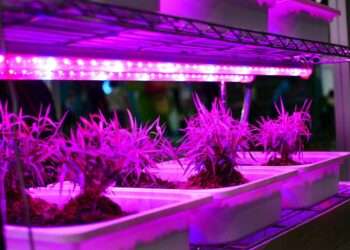Vertical farming systems have emerged as a viable and efficient solution to meet rising food demands in urban areas, reduce land dependency, and maintain year-round crop production. By growing plants in vertically stacked layers under controlled environmental conditions, growers can maximise output while conserving space and resources. This method is especially beneficial for crops that have short growth cycles, compact sizes, and high market demand.
Success in vertical farming heavily depends on optimising every aspect of the growing environment, including horticultural lighting solutions. Artificial lighting plays a critical role in influencing photosynthesis, plant morphology, and yields. In this space, LED grow lights have become a preferred choice due to their energy efficiency and spectrum control.
7 Best Crops to Grow in Vertical Farming Systems
1. Lettuce
Lettuce is one of the most commonly grown crops in vertical farming. Its compact size, quick growth cycle, and high market demand make it ideal for this system. Different lettuce varieties, such as romaine, butterhead, and oakleaf, thrive under well-regulated light and nutrient conditions. Using LED grow lights with tailored spectra allows growers to enhance leaf colour and increase nutritional content. Uniform illumination from LED Luminaire systems ensures consistent yields across layers.
2. Spinach
Spinach adapts well to vertical farming environments due to its low light and space requirements. It is a nutrient-dense leafy green that responds positively to high-quality lighting regimes. Proper horticultural lighting solutions can boost leaf thickness and reduce nitrate accumulation. Research suggests that specific wavelengths in LED grow lights influence phenolic compound development in spinach, contributing to both flavour and shelf life.
3. Basil
Herbs like basil are profitable vertical farm crops due to their high value and aroma-sensitive growth. Basil’s essential oil production is light-dependent, and spectrum-adjusted LED Luminaire systems can enhance its flavour profile. Controlled humidity, temperature, and high-quality horticulture lights also prevent common issues like mildew.
Also Read: A Guide to Buying Property in Qatar Doha for Women Investors
4. Strawberries
While more challenging, strawberries are gaining popularity in advanced vertical systems. They require a balanced lighting environment for flowering and fruiting. Implementing dynamic LED grow lights improves flowering initiation and accelerates ripening. With accurate temperature and CO₂ control, vertical setups supported by robust horticultural lighting solutions can yield high-quality fruits year-round. The LL-CV Series from Valoya is a customisable LED lighting platform, designed for seamless integration into diverse rack and room configurations. This makes it particularly suitable for tiered fruiting crops like strawberries, which demand specific lighting angles and intensities at different growth phases.
5. Kale
Kale is well-suited for vertical systems due to its upright growth and resilience. It benefits from spectrum-controlled lighting that promotes leaf expansion and pigment synthesis. Research indicates that blue and red light ratios influence secondary metabolite production in kale. Using LED grow lights designed for dense canopy penetration helps ensure quality and consistency, especially in taller growth stages.
6. Microgreens
Microgreens such as radish, arugula, and mustard are among the fastest crops to produce, often ready in 7–14 days. These crops require minimal vertical space and benefit greatly from uniform and customisable horticultural lighting solutions. Spectrum-specific LED grow lights can enhance colour vibrancy, nutrient density, and flavour concentration. Trusted high-quality horticulture lights are essential to maintain consistent photoperiods and optimal photosynthetic activity throughout short crop cycles.
Selecting the right crops is fundamental to optimising the efficiency and profitability of vertical farming systems. Each plant has specific physiological requirements related to light intensity, spectrum, photoperiod, and nutrient delivery. Crops like lettuce, spinach, microgreens, and dwarf tomatoes respond well to controlled environments, provided that lighting and climate systems are calibrated to their needs.
The advancement of high-quality horticulture lights, especially LED grow lights, has enabled growers to precisely manage plant development while maintaining energy efficiency. Spectrum control not only supports faster growth but also enhances qualities like colour, flavour, and nutrient density. As vertical farming continues to evolve, the integration of adaptable horticultural lighting solutions will remain a cornerstone of success. For researchers and commercial growers alike, aligning crop selection with appropriate lighting strategies is key to achieving consistent yields, minimising resource inputs, and ensuring long-term viability in indoor agriculture.








